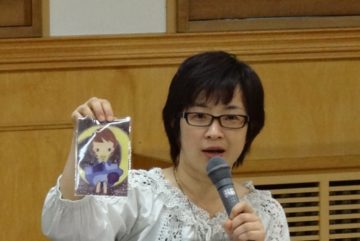Nobuki: We now move on to a different subject. I met your sons and many other children from Fukushima. These children were living in constant fear of radiation hazard. They had hopes for their future, but were spending uneasy, sleepless nights. In the summer of 2011, children who gathered to study or play together often talked each other about the iodine tablets. “Have you taken the tablets?” or “Mom said there was no need to take, so it’s kept in the drawer.” While they were playing on the lawn of St. Ignatius Church or the nearby bank of the moat of Edo-jo Castle, they always asked us “May we touch this?”, “Can I sit here?”, “If I touch the lawn when I was in Fukushima, Mom says No! But, we are in Tokyo, so it’s OK?” Children, though young as they are, worry very much about their health. “I do not drink milk given at school lunch.”; “We are not allowed to eat yoghurt either.” These became the topic of their daily conversation. Summer 2011 was also just about the time when children started asking to return to Fukushima. This was because Tokyo is tremendously hot in summer, and the air is not fresh. The children would proudly declare that Fukushima, a place blessed with the abundance of nature, had “blue skies, beautiful mountains, and delicious food”. When asked how they found Tokyo, they answered “No good at all. The air is filthy with smelly exhaust gas; the subway trains are like strange snakes”. They had seldom taken trains when they were in Fukushima, it seemed bothersome they had to do so whenever they went out in Tokyo.
It is an urgent concern of fathers and mothers to protect their children. Mr. K, who is a scientist himself, checked the dust around his house, and proved how high the radiation was there.
Ms. K: It may be hard for those who live in Tokyo to get the picture of what radioactive decontamination is like. Tokyo is a town in concrete. Concrete buildings and roads can be decontaminated by washing with water, and that is it. However, it is quite a different story in Fukushima, where most part of the surface is soil and woodlands; radioactive substance on the ground rises up in the wind when the soil gets dry, falls down on the ground again, which will be repeated every time when the wind blows. With the soil, it gets carried into rivers. Children play on the ground where the dust goes up in the air and that is where the radioactivity level is the highest. Children inhale radioactively contaminated dust into their lungs and then into their blood. Younger children are at a greater risk of inhaling such particles, especially infants who crawl. But, we cannot keep them on high places all the time. The Iwaki City Office issued directives not to dry Japanese radish on the ground; but at a level of the least one meter above the ground. Otherwise, they would become inedible. However, children like to play on the ground, eat their lunch sitting on the ground, or play in the sandbox. When they sweep their classrooms, dust will float around and when measured, records high readings on the dosimeters. Radiation readings have been the highest at school entrances. We are very concerned that our children would breathe in the radioactive particles.
Nobuki: The decontamination operations are being carried out now in Fukushima and Koriyama Cities. Topsoil is removed, packed into plastic cases, covered by blue sheets and placed in the corner of the gardens of the owners. I heard that the level of radioactivity rose particularly high there. Is this an effective way of decontamination? After all, people still could not escape from the serious health hazard. An owner of the house asked the press: “Is this really the way it should be carried out?” This was a case in Tamura City, which was reported in the Asahi Shimbun today.
Ms. K: Yes, that story was on the front page of the Asahi Shimbun. Tamura City is classified into Compulsory Evacuation Zone, and was decontaminated. But the radioactivity level remained high above 1mSv/y, even after the decontamination. The Japanese Government notified the City that there was no budget left to continue the decontamination. City Officials were told to provide dosimeters to those who requested for it, and residents were to decide for themselves, whether it was safe to continue living there. It is quite absurd to say to those who were not scientists: “Decide for yourselves whether it is safe”. This is what the Government did to the people in Fukushima. Of course, the Tamura citizen is not comfortable with the radiation level after the decontamination. On the other hand, the radiation level in Koriyama and Fukushima cities reads around the same level as Tamura City’s. However, there is no evacuation order for these cities. The people in these cities are under the same high levels of radiation. Yet, they did not receive any dosimeters, but have to live under the same conditions of radiation. I simply cannot understand it.

